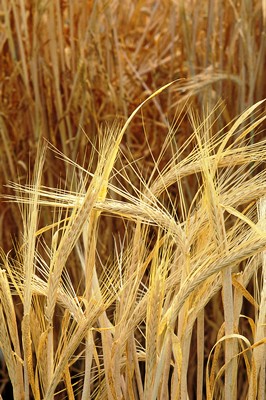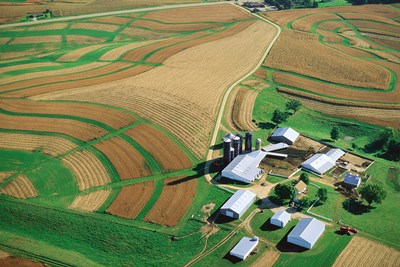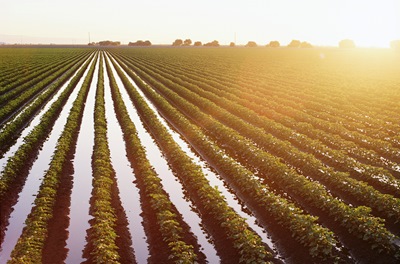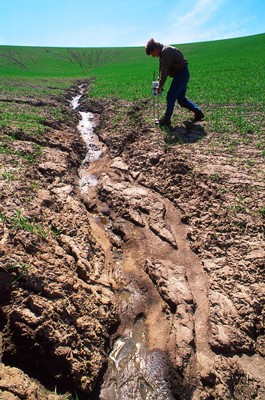From the start, Izaak Walton League members understood the connection between agriculture and natural resources. That’s why the League has long advocated for conservation programs to be part of national farm policy. At the same time, League members have also worked to support America’s farmers and farm economies.
In the early 1930s, when migratory bird populations were decimated due to drought, the League sponsored farmer-hunter partnerships to encourage use of marginal farmland for bird habitat. In 1937, Ikes adopted a resolution calling for a national program to retire fields in mountainous areas from agricultural use. Our work to clean up America’s waterways included efforts to limit farmland erosion and encourage farming practices that reduce soil erosion.
The Walton Soil Proposal of 1955 recommended that instead of using federal money to shore up crop prices, the government should pay farmers to retire marginal farmland as “conservation reserves.” The retired land would become a long-term “soil bank.” Congress adopted the Soil Bank program in 1955, but by the early 1970s, the program had faded away. The League worked with Congress to create several new conservation programs, including Sodbuster and the Conservation Reserve, that were implemented in the 1985 Farm Bill. The League has worked since then to strengthen Farm Bill conservation programs and ensure the programs are fully funded by Congress every year.
Conservation Crisis
These Farm Bill conservation programs and the resources they were intended to protect are in jeopardy today due to an unusual set of circumstances. Commodity prices are at historically high levels, encouraging production on every available acre and fueling conversion of marginal lands to crop production. At the same time, the purchasing power of Farm Bill conservation programs is eroding as crop prices drive up land prices and rental rates and Congress continues to cut conservation program budgets.
Moreover, the long-standing covenant between farmers and American taxpayers is breaking down. For decades, taxpayers have provided generous income support and an insurance safety net to farmers. These voluntary programs require producers to implement common-sense conservation measures if they accept program benefits. This arrangement is known as “conservation compliance,” and it’s been standard practice for years. However, many of the Farm Bill’s traditional income support programs are not providing payments because commodity prices are so high that payments are not being triggered, which means conservation compliance does not apply. In addition, this shift has not delivered meaningful savings for taxpayers because subsidies to producers have increased in other areas, especially subsidized premiums for crop insurance.
As taxpayer subsidies for crop insurance premiums continue to increase, taxpayers are receiving fewer conservation benefits for their investment. That’s because conservation compliance does not apply to the federal crop insurance program. Conservation is eroding out of our nation’s farm policy.
Decisions made by Congress in the coming months will have a profound impact on conservation and our country’s landscape. During debates on the 2012 Farm Bill, members of Congress will decide which payment programs will be included and what — if any — conservation requirements will accompany those payments. This makes the 2012 Farm Bill debate critically important to all Americans.
What Is the Farm Bill?
America’s farm policy was developed in the 1930s in response to the catastrophic effects of the Great Depression on farm and rural economies. The Farm Bill affects more U.S. land than any other single piece of federal legislation. That’s because more than 50 percent of the land in the United States — nearly 1 billion acres — is in agricultural use, from cropland and farmsteads to grassland pastures and grazed forest land.
 The Farm Bill is a package of laws that govern a wide range of farm income support, conservation, and food assistance programs. Each Farm Bill is made up of policy sections called “titles” that cover areas such as commodities, conservation, trade, nutrition, rural development, and research.
The Farm Bill is a package of laws that govern a wide range of farm income support, conservation, and food assistance programs. Each Farm Bill is made up of policy sections called “titles” that cover areas such as commodities, conservation, trade, nutrition, rural development, and research.
There have been 16 Farm Bills in our nation’s history. Congress revisits this legislation approximately every five years to ensure the policies are responsive to current needs and market conditions. This offers an opportunity for Americans to voice their concerns and provide input on how the legislation should be shaped. The most recent Farm Bill was enacted in 2008 and expires this year.
When the last Farm Bill was enacted, the budget to implement it was estimated at $58 billion per year — more than $285 billion for the fiveyear bill. The majority of this spending is concentrated in four Farm Bill titles. Nutrition accounts for 66 percent (dominated by the Supplemental Nutrition Assistance Program, formerly known as the Food Stamp Program). Commodity, conservation, and crop insurance titles together account for 31 percent of Farm Bill spending and are the main way tax dollars are provided to agricultural producers and landowners.
The Farm Bill is an “authorization” bill — it establishes policies and programs and authorizes specific funding amounts for each. However, the money for Farm Bill programs is provided through an annual “appropriations” process in Congress. Appropriations bills determine how much money can be drawn from the U.S. Treasury and spent on a program in a given year. Appropriations bills are not required to provide the exact funding amounts outlined in authorization bills — and often do not.
Congress is working to cut billions of dollars from federal spending, and the 2012 Farm Bill will contribute to these spending cuts. In fact, the Farm Bill passed in April by the Senate Agriculture Committee cut authorized appropriations levels for the conservation title by approximately $6 billion over the next 10 years. However, Farm Bill programs can be responsive to conservation needs and fiscal constraints at the same time. The Izaak Walton League has identified policy priorities for the 2012 Farm Bill that can be implemented within the existing framework and without additional spending. In fact, these recommendations can save taxpayer dollars while also ensuring conservation benefits. Taking these steps will promote sustainable agriculture, conserve fish and wildlife habitat, and provide economic opportunities for all Americans.
Many Farm Bill programs that provide subsidies to farmers include a provision known as conservation compliance. This system ensures that when public funds are voluntarily accepted by producers, the public benefits through basic protections for soil, water, and wetlands. However, the federal crop insurance program — soon to be the largest Farm Bill subsidy for farmers — does not carry such common-sense conservation provisions.
The problem has its roots in the 1996 Farm Bill, when lawmakers exempted crop insurance from long-standing conservation standards. The justification at the time was to encourage more farmers to sign up for crop insurance, which would decrease federal disaster assistance costs. Since then, crop insurance enrollments rates have exploded: More than 264 million acres are insured across the country, including more than 80 percent of corn, soybean, wheat, cotton, and peanut crops. This means that subsidy costs have exploded as well.
Heavily Subsidized Safety Net
Providing crop insurance as a “safety net” for American farmers makes sense. Farming is risky, and crop insurance can protect against the unpredictability of weather and ensure producers can continue to meet our nation’s needs. However, crop insurance premiums are costing taxpayers billions of dollars. Federal subsidies for crop insurance premiums grew from $500 million per year in the 1980s to more than $7.4 billion in 2011. On average, taxpayers cover 60 percent of a producer’s crop insurance premiums, although subsidies are often as high as 80 percent. Over the next decade, crop insurance subsidies are projected to account for more Farm Bill spending than any program other than nutrition.
These federal crop insurance policies are very different from the insurance most of us have for our cars or homes. The average American car owner, for example, pays an insurance premium every year but only receives a pay out if the car is damaged. However, many crop insurance policies pay out regardless of whether a crop is damaged, flourishing, or anything in between — encouraging risky agricultural production that often works against our nation’s conservation goals.
Taxpayers Lose Conservation Benefits
 Crop insurance policies can be used to guarantee a producer’s revenue for a specific crop year — regardless of actual production and with no limits on payments. Without a conservation compliance requirement, the crop insurance program rewards expanded production without consideration for damage to soil or wetlands or even land productivity.
Crop insurance policies can be used to guarantee a producer’s revenue for a specific crop year — regardless of actual production and with no limits on payments. Without a conservation compliance requirement, the crop insurance program rewards expanded production without consideration for damage to soil or wetlands or even land productivity.
Policy changes proposed by Congress for the 2012 Farm Bill could further weaken conservation efforts. Direct payments and other income support for major crop producers have historically been connected with conservation compliance. However, with record-high crop prices and the need to reduce the federal budget deficit, it is widely anticipated that Congress will eliminate direct payments in the 2012 Farm Bill — and the Farm Bill adopted by the Senate Agriculture Committee this April does just that. Eliminating these payments will cut one of the main connections between conservation and the Farm Bill.
Although eliminating direct payments will yield savings for taxpayers, spending for crop insurance subsidies will grow at the same time. Moreover, there is steadfast opposition among commodity groups to reconnecting conservation compliance provisions to crop insurance subsidies.
However, at a time when federal funding for Farm Bill conservation programs is decreasing, this requirement is especially important. Reinstating basic standards to protect soil and wetlands as part of the largest farm subsidy program will help conserve fish and wildlife, protect drinking water supplies, and provide flood protection across the country. In addition, withholding taxpayer-provided subsidies from farmers who choose not to meet basic conservation standards will save taxpayer dollars. In June, the full Senate approved a Farm Bill amendment to reconnect crop insurance with conservation compliance.
Intensive agricultural production and overgrazing of America’s plains in the 1920s and earlier were followed by extreme drought in the early 1930s. Crops failed, leaving the soil dry and exposed — turning once fertile grasslands into a massive “Dust Bowl.” Many families lost their farms. In 1935, Congress established the Soil Conservation Service and made funding available to farmers who implemented conservation practices on their lands, which helped farm families get back on their feet.
However, decades of agricultural expansion have left only a fraction of our country’s native grasslands intact today. Many of these lands have little value for crop production but have significant environmental, habitat, and other values. For example, the native grasslands of America’s northern plains are integral to the livelihoods of ranching families, providing feed for cattle and other livestock. Prairie grasslands also provide critical breeding and nesting areas for migratory waterfowl, song birds, and other wildlife. Approximately half of all ducks in North America are born in this region of the United States. Once grasslands are converted to agriculture or other uses, however, it is almost impossible to restore the ecosystem services — soil conservation, improved water quality, wildlife habitat, and outdoor recreation — these lands provide.
Balancing Conservation with Fiscal Constraints
With the potential of big rewards under high commodity prices and limited financial risk for producers due to highly subsidized crop insurance, there is now a strong financial incentive to convert remaining native lands to agricultural production. That’s why the 2012 Farm Bill must include a nationwide “Sodsaver” provision.
 Sodsaver will strengthen Farm Bill conservation goals by limiting federal farm program and crop insurance subsidies for native land that is converted to agricultural production if that land has no prior cropping history. The program will not prevent landowners from using their land as they choose, but it will ensure that taxpayers no longer subsidize potentially destructive actions on America’s remaining native lands.
Sodsaver will strengthen Farm Bill conservation goals by limiting federal farm program and crop insurance subsidies for native land that is converted to agricultural production if that land has no prior cropping history. The program will not prevent landowners from using their land as they choose, but it will ensure that taxpayers no longer subsidize potentially destructive actions on America’s remaining native lands.
Fortunately, the League is making progress on this issue. The Farm Bill adopted by the Senate Agriculture Committee in April includes Sodsaver provisions that we support. Under this bill, crop insurance subsidies would be reduced by 50 percentage points on any native land converted to annual crops. (For example, if a producer currently receives an insurance premium subsidy of 62 percent, that subsidy would be cut to 12 percent under this provision.) It would also deny other income and subsidy payments if these lands are converted to annual crops. Identical legislation was introduced in the House of Representatives in May, and the League is actively supporting it.
This new Sodsaver provision isn’t perfect, but it represents a solid first step toward reducing taxpayer incentives to plow under the last remnants of America’s native prairie and grasslands.
Investments in agricultural conservation to date have been successful, and benefits to soil, water, and fish and wildlife habitat can be traced directly back to publicly funded conservation programs. Consider some of the achievements of Farm Bill conservation programs in 2010 alone:
- Through more than 5,600 projects, landowners restored about 289,000 acres of wetlands.
- 82,000 program participants implemented wildlife management practices on 12.6 million acres of upland.
- 159,000 conservation crop rotation plans were developed to protect more than 6 million acres of soil.
However, like any investment, when costs increase, our dollars don’t go nearly as far. As crop prices and land values have risen dramatically, the purchasing power of federal conservation dollars has dropped significantly. This means that even if funding remains at current levels, conservation dollars cannot achieve the same results. The problem is only compounded when annual funding is far below the levels authorized in the Farm Bill.
We recognize that the next Farm Bill will cut conservation funding as part of the broader effort to reduce government spending. Our goal is to ensure that conservation programs achieve real conservation results and receive fair treatment with respect to all other authorized Farm Bill spending programs. To do so, the 2012 Farm Bill must:
Maintain the unique functions of current Farm Bill conservation programs. Conservation programs will almost certainly be consolidated as part of Farm Bill cost-cutting efforts. In fact, the Wetlands Reserve Program was consolidated with several other programs in the 2012 Farm Bill approved by the Senate Agriculture Committee in April. Although it makes sense to eliminate redundant initiatives, the Farm Bill should not eliminate or undermine important conservation functions such as restoring wetlands or protecting rangeland. These unique functions must be maintained within consolidated Farm Bill programs.
Establish continuing-baseline status for conservation program spending. Unlike the commodity and crop insurance programs, which are automatically included in each new Farm Bill budget (known as a “continuing baseline”), many key conservation programs do not have a similar status. So rather than program costs being assumed in the next Farm Bill budget, new funding sources or offsets (reductions in other spending or revenue increases) must be obtained for each of the programs to have a place in the next Farm Bill budget. This puts conservation at a distinct disadvantage in every Farm Bill debate.
Conservation should be on the same footing as other Farm Bill programs. The continuing baseline status enjoyed by commodity and crop insurance programs must be extended to the unique services provided by conservation programs. The Senate Agriculture Committee took a step in this direction when it provided permanent (baseline) status for the combined easement program that includes the Wetlands Reserve Program.
Appropriate annual funding equal to authorized spending levels for mandatory Farm Bill conservation programs. Securing a long-term commitment to conservation in the Farm Bill does nothing to correct the problem of cuts made in annual appropriations for these programs. Between fiscal years 2003 and 2012, Congress cut annual funding (appropriations) for conservation by $4.6 billion below the investments (authorizations) called for in the Farm Bill.
The failure of Congress to honor its commitment to appropriate full conservation funding for the Farm Bill each year undermines rural economies and on-the-ground conservation. It is important that citizens and their representatives in Congress oppose annual reductions in conservation investment. Accountability begins when the Farm Bill is signed into law, and all conservation commitments must be honored each year.
Conservation Investments Ensure a Healthy Future
 The 2012 Farm Bill provides an opportunity to invest in the future of America’s agricultural system and our natural resources. The two are intertwined — something Ikes have known from the start of our organization.
The 2012 Farm Bill provides an opportunity to invest in the future of America’s agricultural system and our natural resources. The two are intertwined — something Ikes have known from the start of our organization.
With billions in farm subsidies on the table, it’s worth taking time to ensure American taxpayers receive an adequate return on their investment. Re-establishing the connection between crop insurance premium subsidies and conservation compliance will encourage sound conservation practices. Enacting a nationwide Sodsaver provision will help protect native prairie and grasslands that are critical to ranching families and fish and wildlife.
Farm Bill conservation programs safeguard and restore water quality, wetlands, soils, and other natural resources, which benefits communities nationwide. To achieve these results in the future, it is critical that we maintain the unique functions of the current Farm Bill, maintain our investments in conservation, and ensure that conservation has equal footing with other Farm Bill programs. It’s important to achieve these goals not only in the Farm Bill itself but in every annual Farm Bill budget approved by Congress.